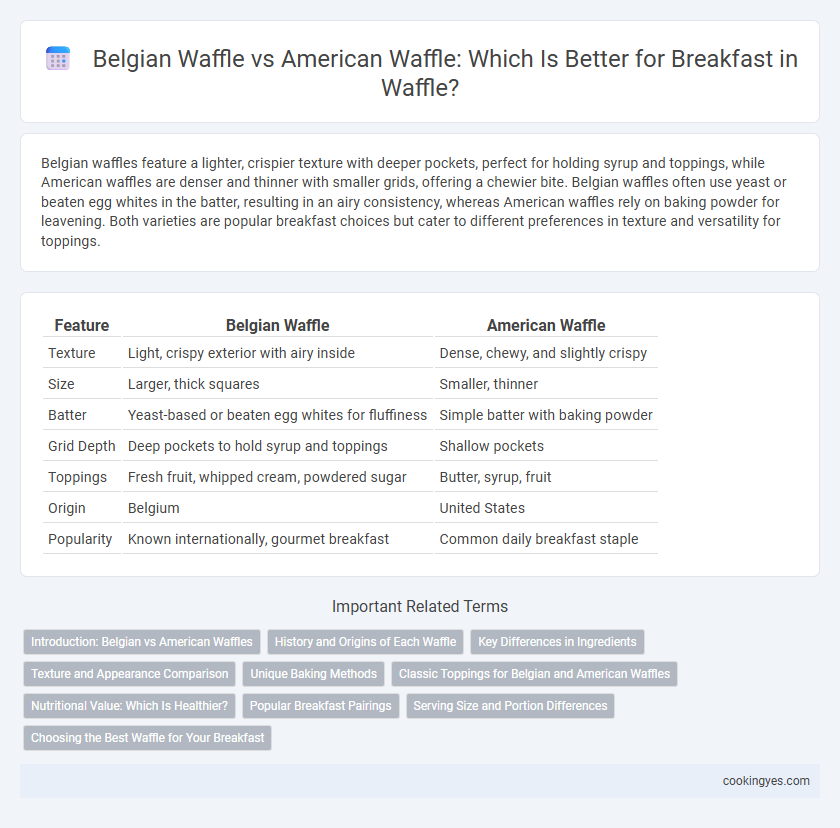Belgian waffles feature a lighter, crispier texture with deeper pockets, perfect for holding syrup and toppings, while American waffles are denser and thinner with smaller grids, offering a chewier bite. Belgian waffles often use yeast or beaten egg whites in the batter, resulting in an airy consistency, whereas American waffles rely on baking powder for leavening. Both varieties are popular breakfast choices but cater to different preferences in texture and versatility for toppings.
Table of Comparison
| Feature | Belgian Waffle | American Waffle |
|---|---|---|
| Texture | Light, crispy exterior with airy inside | Dense, chewy, and slightly crispy |
| Size | Larger, thick squares | Smaller, thinner |
| Batter | Yeast-based or beaten egg whites for fluffiness | Simple batter with baking powder |
| Grid Depth | Deep pockets to hold syrup and toppings | Shallow pockets |
| Toppings | Fresh fruit, whipped cream, powdered sugar | Butter, syrup, fruit |
| Origin | Belgium | United States |
| Popularity | Known internationally, gourmet breakfast | Common daily breakfast staple |
Introduction: Belgian vs American Waffles
Belgian waffles are characterized by their larger size, deeper pockets, and lighter texture, making them ideal for holding syrup and toppings, while American waffles tend to be thinner with a denser, cake-like consistency. The batter for Belgian waffles typically contains yeast or whipped egg whites, resulting in a crispier exterior, compared to the chemical leaveners used in American waffle batter. These distinctions influence breakfast preferences, with Belgian waffles often favored for gourmet-style breakfasts and American waffles commonly appearing in traditional diners.
History and Origins of Each Waffle
Belgian waffles originated in Belgium during the Middle Ages, known for their deep grids and light, crispy texture, originally made using yeast batter. American waffles evolved from European recipes brought by settlers, adapting into thinner, denser versions often leavened with baking powder for quicker preparation. Both waffles reflect regional preferences influenced by ingredients, cooking methods, and cultural traditions shaping breakfast menus worldwide.
Key Differences in Ingredients
Belgian waffles use a batter enriched with yeast or beaten egg whites, resulting in a lighter, crispier texture with deeper pockets ideal for holding syrup or toppings. American waffles typically have a denser batter made with baking powder, yielding a thinner, chewier consistency and smaller grid size. The difference in flour type, sugar content, and fat also influences taste and texture, with Belgian recipes often incorporating more butter and sugar for a richer flavor.
Texture and Appearance Comparison
Belgian waffles feature a lighter, crispier texture with deeper, larger pockets that hold syrup and toppings effectively, creating a visually appealing, golden-brown grid pattern. In contrast, American waffles tend to be denser and thinner with smaller grids, offering a chewier bite and a more uniform surface. The distinct airy structure of Belgian waffles sets them apart in both texture and appearance, making them a popular choice for elaborate breakfast presentations.
Unique Baking Methods
Belgian waffles use a yeast-based batter or beaten egg whites to create a lighter, fluffier texture with deep pockets ideal for holding syrup and toppings. American waffles rely on a batter leavened with baking powder, producing a denser, crispier waffle with shallower grids. These unique baking methods define the distinct taste and texture characteristics preferred in each style for breakfast.
Classic Toppings for Belgian and American Waffles
Belgian waffles are traditionally served with classic toppings like fresh strawberries, whipped cream, and powdered sugar, highlighting their light, airy texture and deep pockets perfect for holding syrup. American waffles often feature butter and maple syrup, with options like fried chicken or bacon adding a savory contrast to their denser, crisp exterior. Both types deliver distinct breakfast experiences, with Belgian waffles favoring sweet, delicate flavors and American waffles embracing hearty, rich accompaniments.
Nutritional Value: Which Is Healthier?
Belgian waffles typically contain more butter and sugar, resulting in higher calories and fat compared to American waffles, which are thinner and often have fewer ingredients. American waffles generally have lower glycemic index values due to their denser texture and lower sugar content, making them a healthier option for sustained energy release. Nutritionally, American waffles provide fewer saturated fats and sugars, contributing to better heart health and weight management when consumed as part of a balanced breakfast.
Popular Breakfast Pairings
Belgian waffles, known for their deep pockets and light texture, are popularly paired with fresh berries, whipped cream, and maple syrup for a sweet breakfast experience. American waffles, typically thinner and denser, are commonly served with butter and syrup or fried chicken, highlighting a savory and hearty morning meal. Both styles offer versatile pairing options that cater to diverse breakfast preferences.
Serving Size and Portion Differences
Belgian waffles typically measure about 7 by 7 inches and are thicker, providing a larger serving size with deeper pockets ideal for holding syrup and toppings. American waffles are generally smaller and thinner, around 4 to 5 inches, resulting in a lighter portion often served in multiples. The difference in serving size affects calorie intake and presentation, making Belgian waffles a more indulgent breakfast choice.
Choosing the Best Waffle for Your Breakfast
Belgian waffles feature a lighter, crispier texture with deeper pockets ideal for holding syrup and toppings, making them perfect for a sweet breakfast experience. American waffles are denser and thinner, offering a more cake-like consistency that pairs well with savory toppings or a classic butter and syrup combination. Choosing the best waffle depends on whether you prefer a fluffy, airy base or a hearty, filling option to suit your morning preferences.
Belgian waffle vs American waffle for breakfast Infographic

 cookingyes.com
cookingyes.com